How Economic Changes Affect Business Decisions and Firms Behavior
VerifiedAdded on 2022/12/28
|11
|2720
|83
Essay
AI Summary
This essay delves into the realm of business economics, examining the intricate relationship between economic fluctuations and the strategic decisions of firms. It meticulously analyzes how changes in the economic landscape, encompassing both microeconomic and macroeconomic factors, directly impact the operational behavior of businesses. The essay provides an in-depth exploration of market dynamics, dissecting the influence of market structures such as perfect competition, monopolistic competition, oligopoly, and pure monopoly on a firm's production and pricing strategies. Furthermore, it elucidates the significance of macroeconomic elements like inflation, unemployment, and the business cycle in shaping corporate profitability and strategic adjustments. By highlighting the cyclical nature of economic prosperity, recession, depression, and recovery, the essay underscores the necessity for businesses to adapt their approaches to navigate the ever-changing economic terrain effectively. This comprehensive analysis offers valuable insights into the complex interplay between economic forces and business practices.
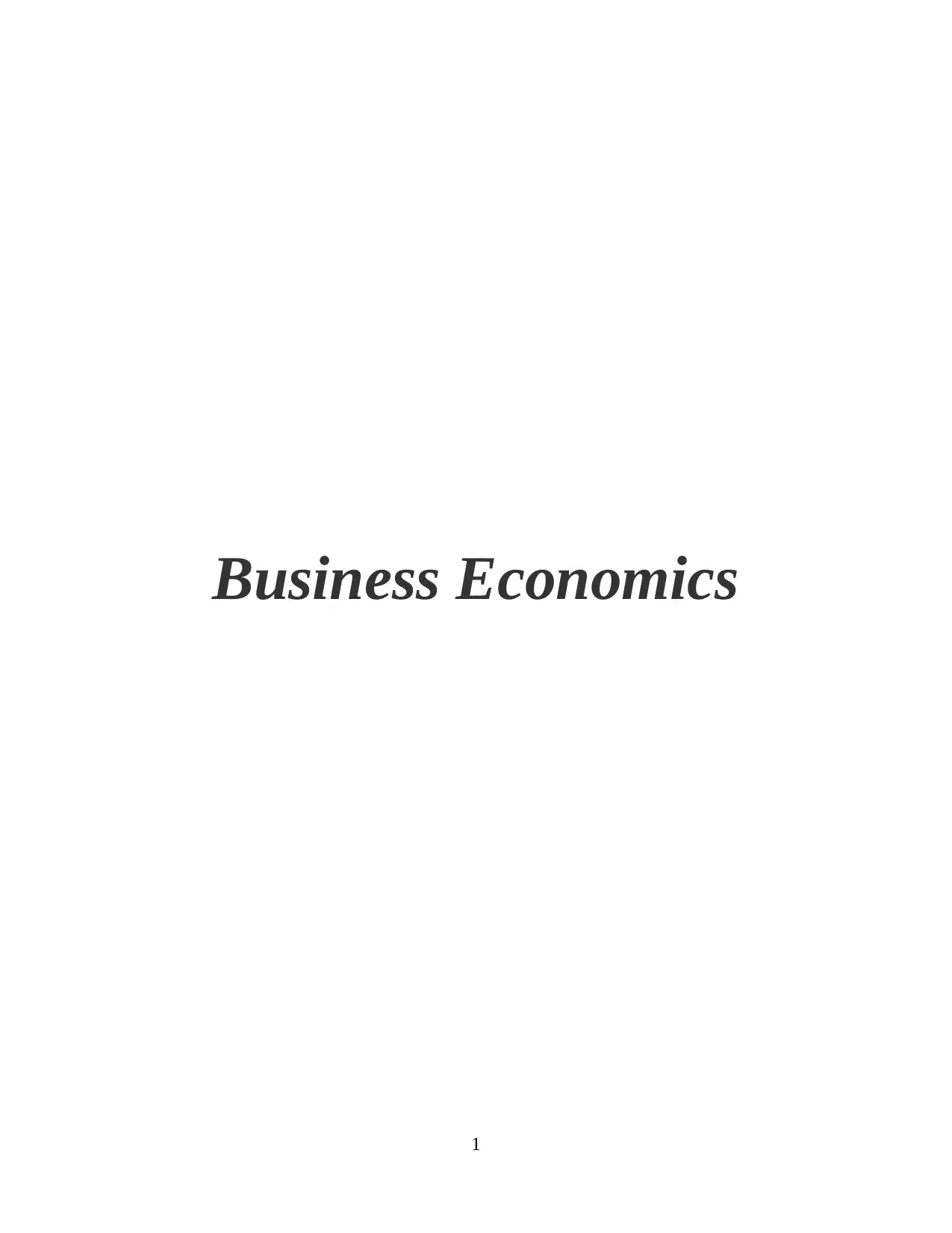
Business Economics
1
1
Paraphrase This Document
Need a fresh take? Get an instant paraphrase of this document with our AI Paraphraser
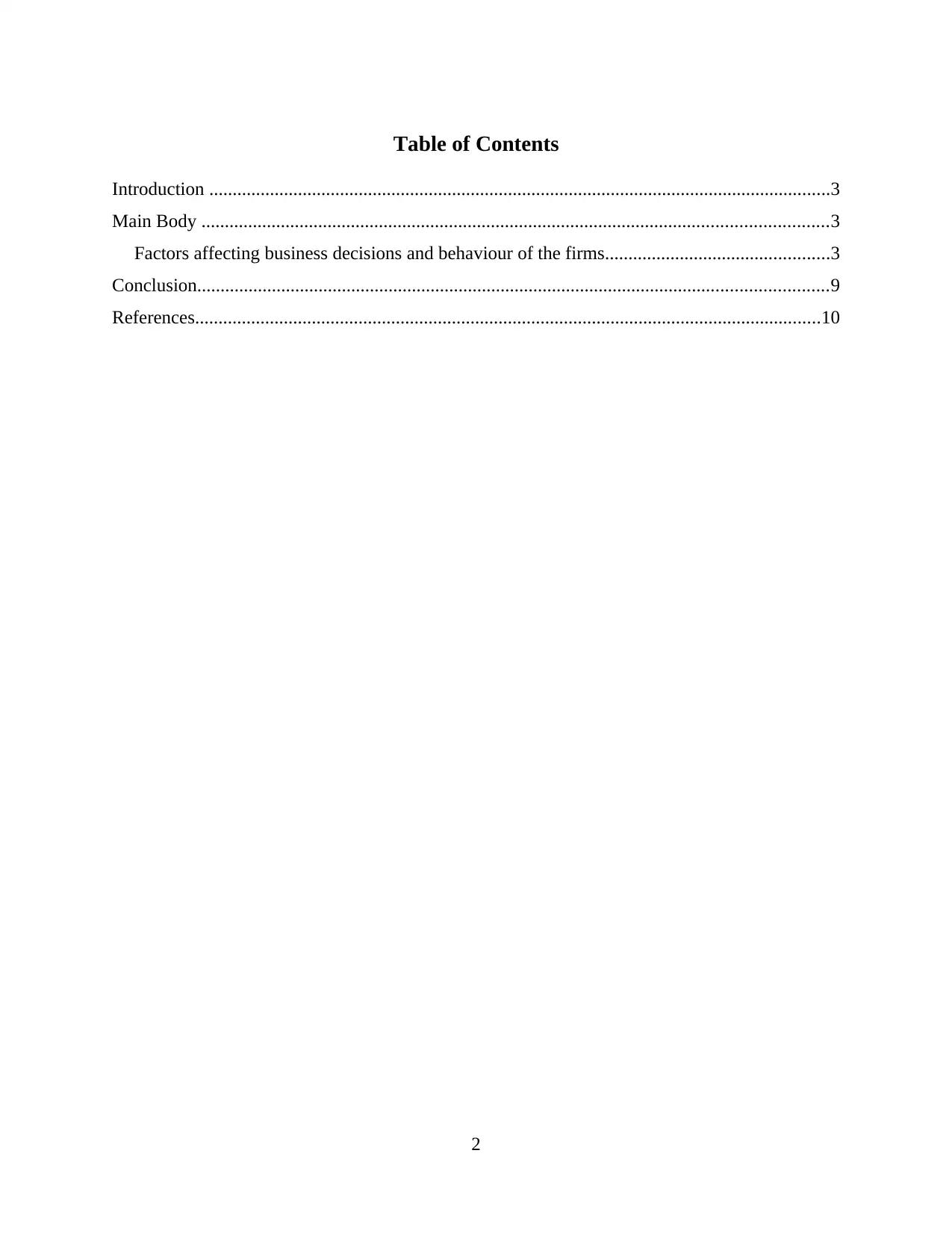
Table of Contents
Introduction .....................................................................................................................................3
Main Body ......................................................................................................................................3
Factors affecting business decisions and behaviour of the firms................................................3
Conclusion.......................................................................................................................................9
References......................................................................................................................................10
2
Introduction .....................................................................................................................................3
Main Body ......................................................................................................................................3
Factors affecting business decisions and behaviour of the firms................................................3
Conclusion.......................................................................................................................................9
References......................................................................................................................................10
2
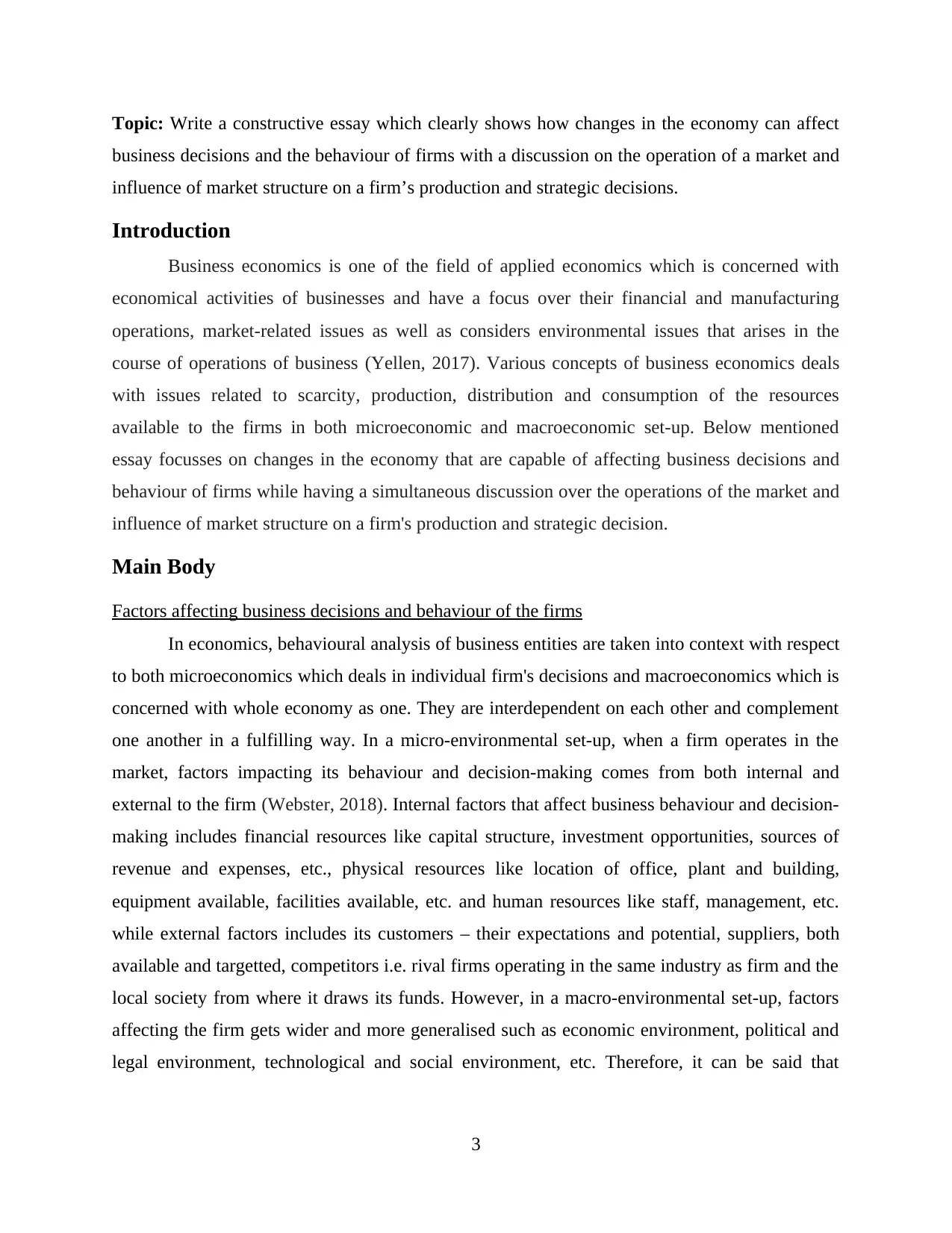
Topic: Write a constructive essay which clearly shows how changes in the economy can affect
business decisions and the behaviour of firms with a discussion on the operation of a market and
influence of market structure on a firm’s production and strategic decisions.
Introduction
Business economics is one of the field of applied economics which is concerned with
economical activities of businesses and have a focus over their financial and manufacturing
operations, market-related issues as well as considers environmental issues that arises in the
course of operations of business (Yellen, 2017). Various concepts of business economics deals
with issues related to scarcity, production, distribution and consumption of the resources
available to the firms in both microeconomic and macroeconomic set-up. Below mentioned
essay focusses on changes in the economy that are capable of affecting business decisions and
behaviour of firms while having a simultaneous discussion over the operations of the market and
influence of market structure on a firm's production and strategic decision.
Main Body
Factors affecting business decisions and behaviour of the firms
In economics, behavioural analysis of business entities are taken into context with respect
to both microeconomics which deals in individual firm's decisions and macroeconomics which is
concerned with whole economy as one. They are interdependent on each other and complement
one another in a fulfilling way. In a micro-environmental set-up, when a firm operates in the
market, factors impacting its behaviour and decision-making comes from both internal and
external to the firm (Webster, 2018). Internal factors that affect business behaviour and decision-
making includes financial resources like capital structure, investment opportunities, sources of
revenue and expenses, etc., physical resources like location of office, plant and building,
equipment available, facilities available, etc. and human resources like staff, management, etc.
while external factors includes its customers – their expectations and potential, suppliers, both
available and targetted, competitors i.e. rival firms operating in the same industry as firm and the
local society from where it draws its funds. However, in a macro-environmental set-up, factors
affecting the firm gets wider and more generalised such as economic environment, political and
legal environment, technological and social environment, etc. Therefore, it can be said that
3
business decisions and the behaviour of firms with a discussion on the operation of a market and
influence of market structure on a firm’s production and strategic decisions.
Introduction
Business economics is one of the field of applied economics which is concerned with
economical activities of businesses and have a focus over their financial and manufacturing
operations, market-related issues as well as considers environmental issues that arises in the
course of operations of business (Yellen, 2017). Various concepts of business economics deals
with issues related to scarcity, production, distribution and consumption of the resources
available to the firms in both microeconomic and macroeconomic set-up. Below mentioned
essay focusses on changes in the economy that are capable of affecting business decisions and
behaviour of firms while having a simultaneous discussion over the operations of the market and
influence of market structure on a firm's production and strategic decision.
Main Body
Factors affecting business decisions and behaviour of the firms
In economics, behavioural analysis of business entities are taken into context with respect
to both microeconomics which deals in individual firm's decisions and macroeconomics which is
concerned with whole economy as one. They are interdependent on each other and complement
one another in a fulfilling way. In a micro-environmental set-up, when a firm operates in the
market, factors impacting its behaviour and decision-making comes from both internal and
external to the firm (Webster, 2018). Internal factors that affect business behaviour and decision-
making includes financial resources like capital structure, investment opportunities, sources of
revenue and expenses, etc., physical resources like location of office, plant and building,
equipment available, facilities available, etc. and human resources like staff, management, etc.
while external factors includes its customers – their expectations and potential, suppliers, both
available and targetted, competitors i.e. rival firms operating in the same industry as firm and the
local society from where it draws its funds. However, in a macro-environmental set-up, factors
affecting the firm gets wider and more generalised such as economic environment, political and
legal environment, technological and social environment, etc. Therefore, it can be said that
3
⊘ This is a preview!⊘
Do you want full access?
Subscribe today to unlock all pages.

Trusted by 1+ million students worldwide
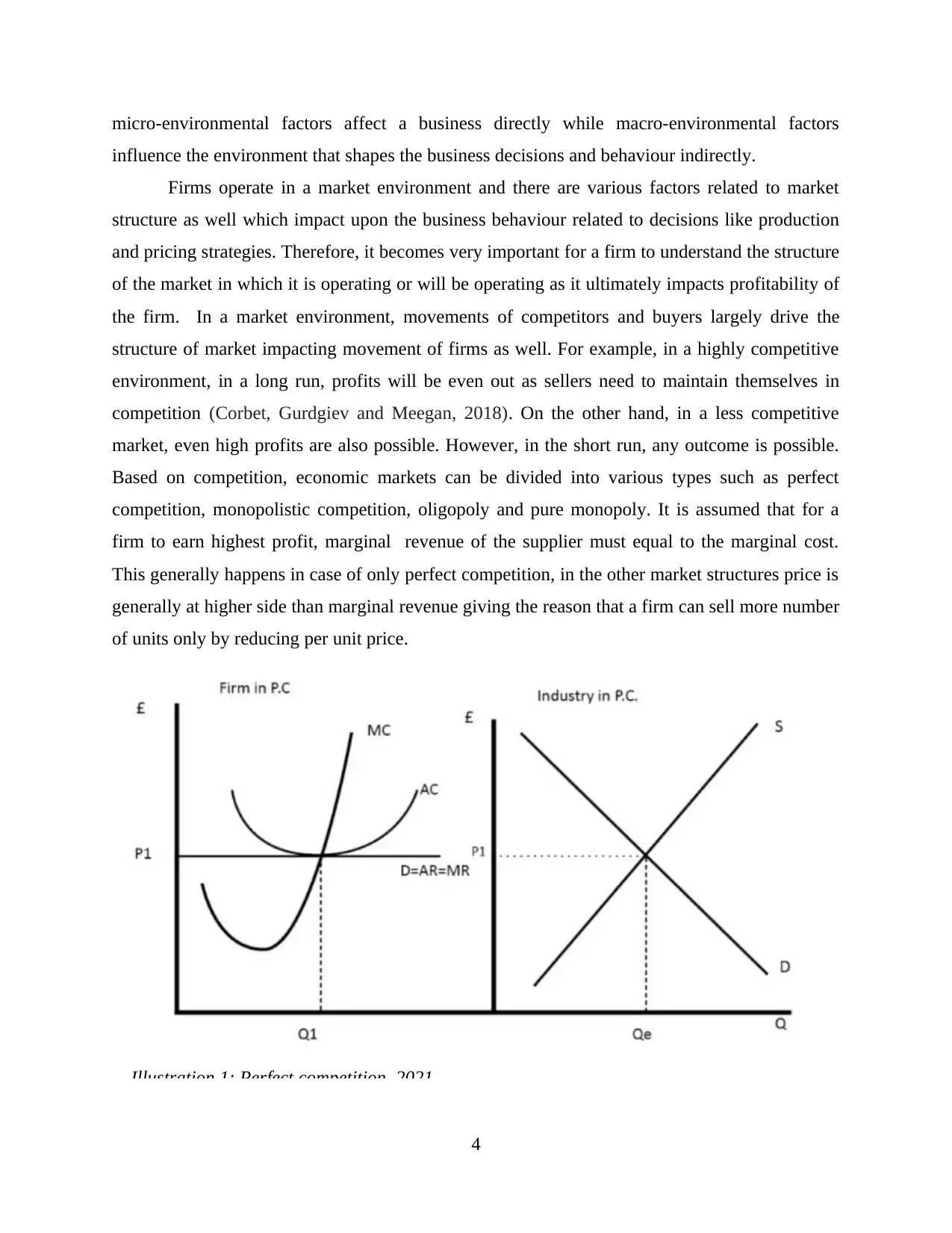
micro-environmental factors affect a business directly while macro-environmental factors
influence the environment that shapes the business decisions and behaviour indirectly.
Firms operate in a market environment and there are various factors related to market
structure as well which impact upon the business behaviour related to decisions like production
and pricing strategies. Therefore, it becomes very important for a firm to understand the structure
of the market in which it is operating or will be operating as it ultimately impacts profitability of
the firm. In a market environment, movements of competitors and buyers largely drive the
structure of market impacting movement of firms as well. For example, in a highly competitive
environment, in a long run, profits will be even out as sellers need to maintain themselves in
competition (Corbet, Gurdgiev and Meegan, 2018). On the other hand, in a less competitive
market, even high profits are also possible. However, in the short run, any outcome is possible.
Based on competition, economic markets can be divided into various types such as perfect
competition, monopolistic competition, oligopoly and pure monopoly. It is assumed that for a
firm to earn highest profit, marginal revenue of the supplier must equal to the marginal cost.
This generally happens in case of only perfect competition, in the other market structures price is
generally at higher side than marginal revenue giving the reason that a firm can sell more number
of units only by reducing per unit price.
4
Illustration 1: Perfect competition, 2021
influence the environment that shapes the business decisions and behaviour indirectly.
Firms operate in a market environment and there are various factors related to market
structure as well which impact upon the business behaviour related to decisions like production
and pricing strategies. Therefore, it becomes very important for a firm to understand the structure
of the market in which it is operating or will be operating as it ultimately impacts profitability of
the firm. In a market environment, movements of competitors and buyers largely drive the
structure of market impacting movement of firms as well. For example, in a highly competitive
environment, in a long run, profits will be even out as sellers need to maintain themselves in
competition (Corbet, Gurdgiev and Meegan, 2018). On the other hand, in a less competitive
market, even high profits are also possible. However, in the short run, any outcome is possible.
Based on competition, economic markets can be divided into various types such as perfect
competition, monopolistic competition, oligopoly and pure monopoly. It is assumed that for a
firm to earn highest profit, marginal revenue of the supplier must equal to the marginal cost.
This generally happens in case of only perfect competition, in the other market structures price is
generally at higher side than marginal revenue giving the reason that a firm can sell more number
of units only by reducing per unit price.
4
Illustration 1: Perfect competition, 2021
Paraphrase This Document
Need a fresh take? Get an instant paraphrase of this document with our AI Paraphraser
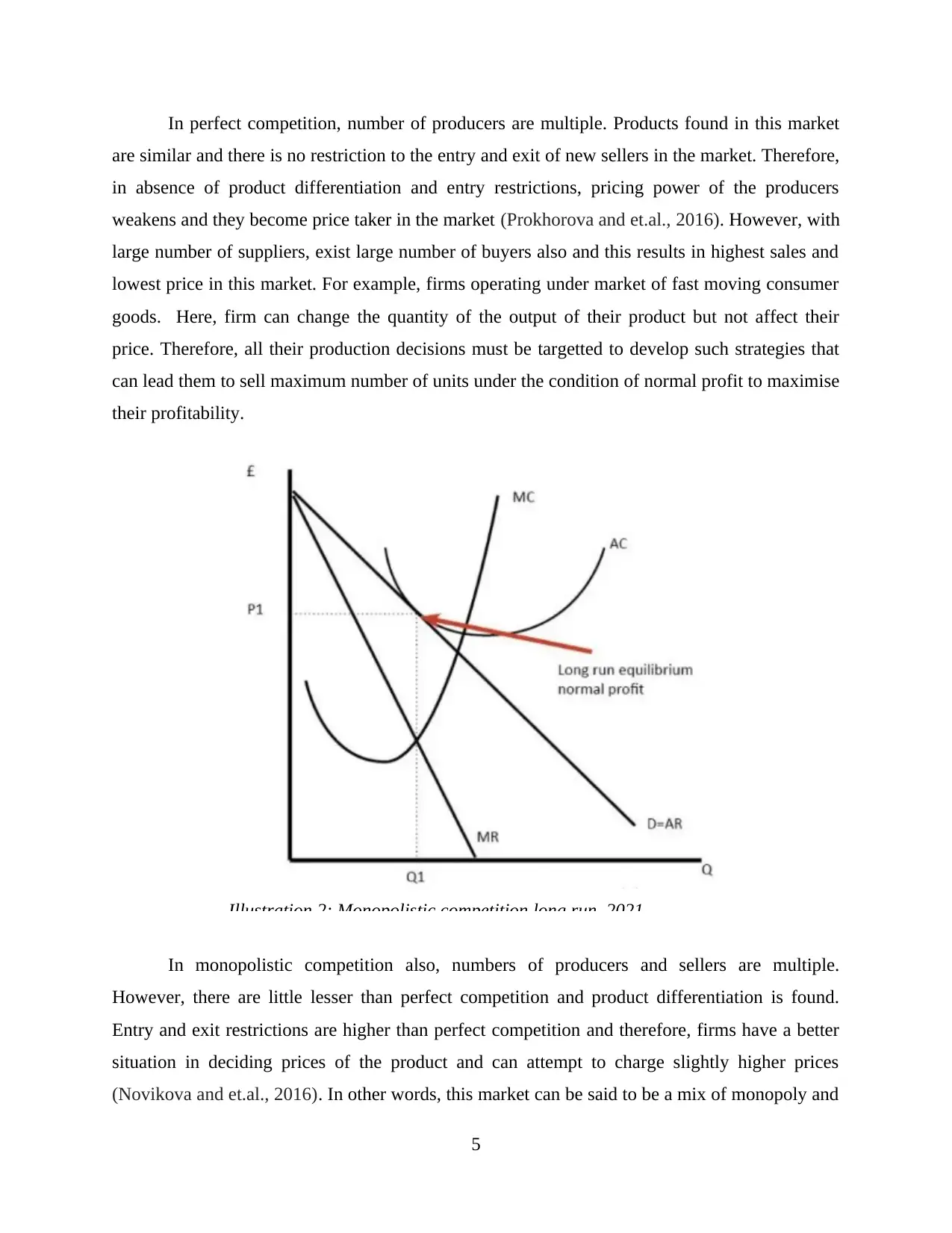
In perfect competition, number of producers are multiple. Products found in this market
are similar and there is no restriction to the entry and exit of new sellers in the market. Therefore,
in absence of product differentiation and entry restrictions, pricing power of the producers
weakens and they become price taker in the market (Prokhorova and et.al., 2016). However, with
large number of suppliers, exist large number of buyers also and this results in highest sales and
lowest price in this market. For example, firms operating under market of fast moving consumer
goods. Here, firm can change the quantity of the output of their product but not affect their
price. Therefore, all their production decisions must be targetted to develop such strategies that
can lead them to sell maximum number of units under the condition of normal profit to maximise
their profitability.
In monopolistic competition also, numbers of producers and sellers are multiple.
However, there are little lesser than perfect competition and product differentiation is found.
Entry and exit restrictions are higher than perfect competition and therefore, firms have a better
situation in deciding prices of the product and can attempt to charge slightly higher prices
(Novikova and et.al., 2016). In other words, this market can be said to be a mix of monopoly and
5
Illustration 2: Monopolistic competition long run, 2021
are similar and there is no restriction to the entry and exit of new sellers in the market. Therefore,
in absence of product differentiation and entry restrictions, pricing power of the producers
weakens and they become price taker in the market (Prokhorova and et.al., 2016). However, with
large number of suppliers, exist large number of buyers also and this results in highest sales and
lowest price in this market. For example, firms operating under market of fast moving consumer
goods. Here, firm can change the quantity of the output of their product but not affect their
price. Therefore, all their production decisions must be targetted to develop such strategies that
can lead them to sell maximum number of units under the condition of normal profit to maximise
their profitability.
In monopolistic competition also, numbers of producers and sellers are multiple.
However, there are little lesser than perfect competition and product differentiation is found.
Entry and exit restrictions are higher than perfect competition and therefore, firms have a better
situation in deciding prices of the product and can attempt to charge slightly higher prices
(Novikova and et.al., 2016). In other words, this market can be said to be a mix of monopoly and
5
Illustration 2: Monopolistic competition long run, 2021
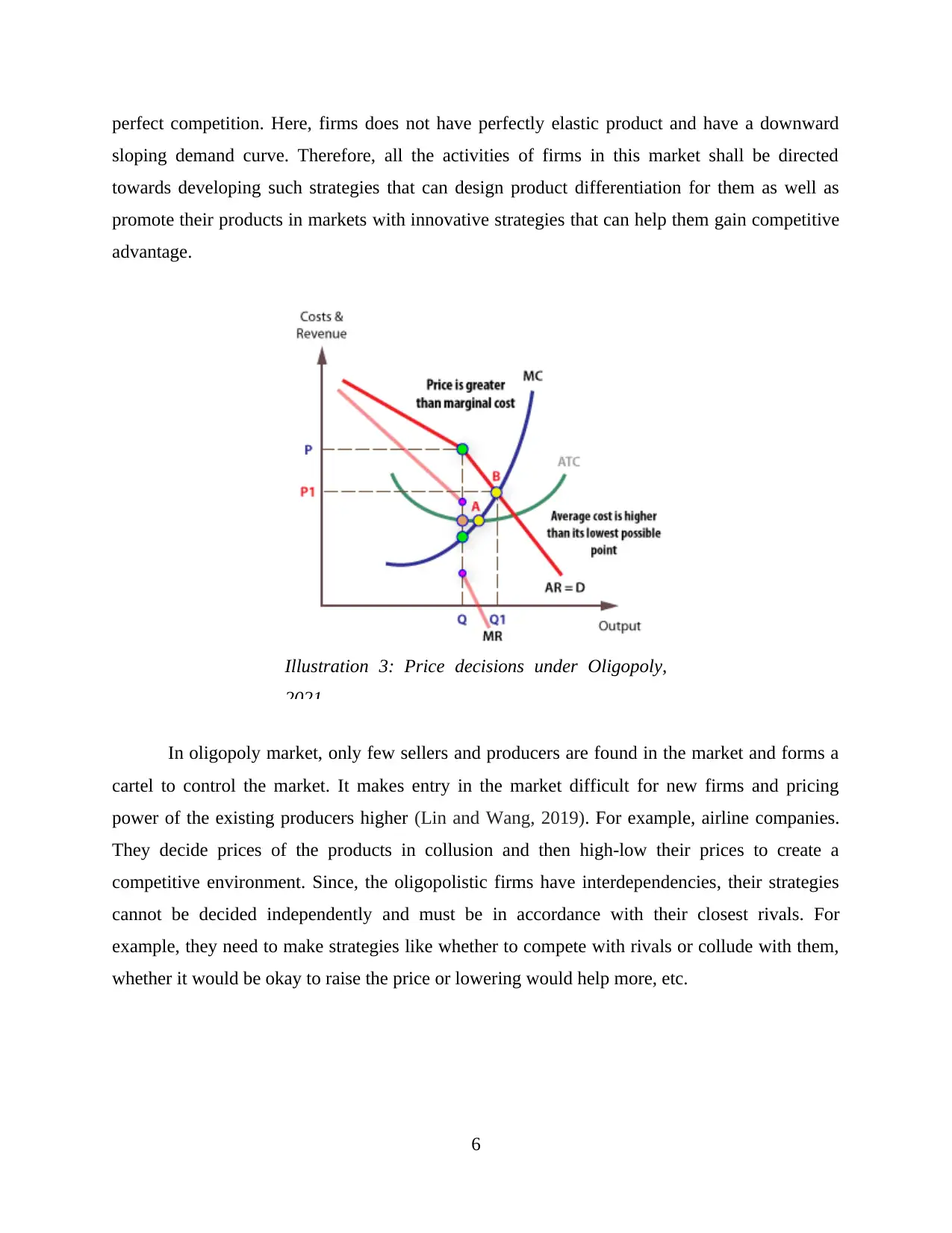
perfect competition. Here, firms does not have perfectly elastic product and have a downward
sloping demand curve. Therefore, all the activities of firms in this market shall be directed
towards developing such strategies that can design product differentiation for them as well as
promote their products in markets with innovative strategies that can help them gain competitive
advantage.
In oligopoly market, only few sellers and producers are found in the market and forms a
cartel to control the market. It makes entry in the market difficult for new firms and pricing
power of the existing producers higher (Lin and Wang, 2019). For example, airline companies.
They decide prices of the products in collusion and then high-low their prices to create a
competitive environment. Since, the oligopolistic firms have interdependencies, their strategies
cannot be decided independently and must be in accordance with their closest rivals. For
example, they need to make strategies like whether to compete with rivals or collude with them,
whether it would be okay to raise the price or lowering would help more, etc.
6
Illustration 3: Price decisions under Oligopoly,
2021
sloping demand curve. Therefore, all the activities of firms in this market shall be directed
towards developing such strategies that can design product differentiation for them as well as
promote their products in markets with innovative strategies that can help them gain competitive
advantage.
In oligopoly market, only few sellers and producers are found in the market and forms a
cartel to control the market. It makes entry in the market difficult for new firms and pricing
power of the existing producers higher (Lin and Wang, 2019). For example, airline companies.
They decide prices of the products in collusion and then high-low their prices to create a
competitive environment. Since, the oligopolistic firms have interdependencies, their strategies
cannot be decided independently and must be in accordance with their closest rivals. For
example, they need to make strategies like whether to compete with rivals or collude with them,
whether it would be okay to raise the price or lowering would help more, etc.
6
Illustration 3: Price decisions under Oligopoly,
2021
⊘ This is a preview!⊘
Do you want full access?
Subscribe today to unlock all pages.

Trusted by 1+ million students worldwide
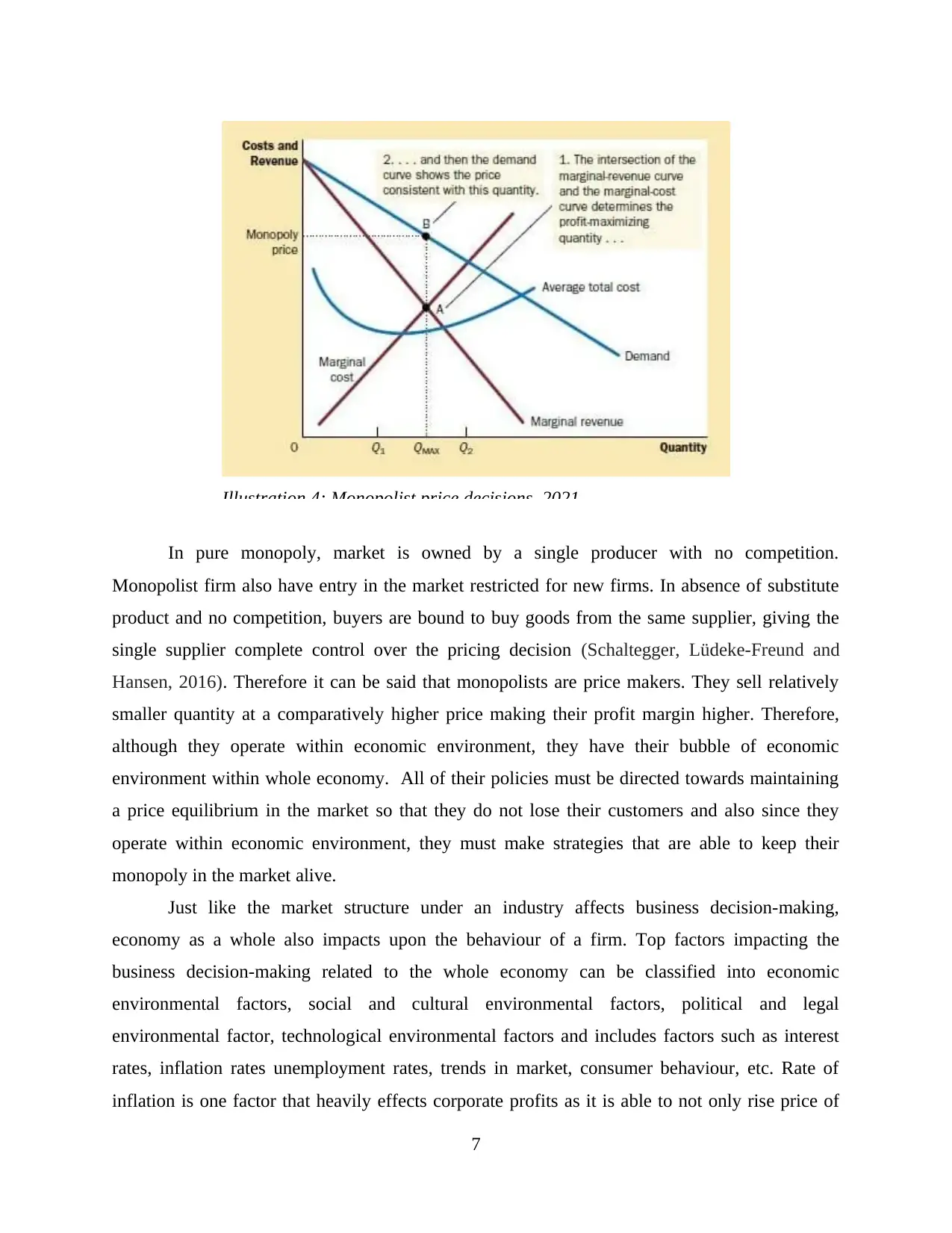
In pure monopoly, market is owned by a single producer with no competition.
Monopolist firm also have entry in the market restricted for new firms. In absence of substitute
product and no competition, buyers are bound to buy goods from the same supplier, giving the
single supplier complete control over the pricing decision (Schaltegger, Lüdeke-Freund and
Hansen, 2016). Therefore it can be said that monopolists are price makers. They sell relatively
smaller quantity at a comparatively higher price making their profit margin higher. Therefore,
although they operate within economic environment, they have their bubble of economic
environment within whole economy. All of their policies must be directed towards maintaining
a price equilibrium in the market so that they do not lose their customers and also since they
operate within economic environment, they must make strategies that are able to keep their
monopoly in the market alive.
Just like the market structure under an industry affects business decision-making,
economy as a whole also impacts upon the behaviour of a firm. Top factors impacting the
business decision-making related to the whole economy can be classified into economic
environmental factors, social and cultural environmental factors, political and legal
environmental factor, technological environmental factors and includes factors such as interest
rates, inflation rates unemployment rates, trends in market, consumer behaviour, etc. Rate of
inflation is one factor that heavily effects corporate profits as it is able to not only rise price of
7
Illustration 4: Monopolist price decisions, 2021
Monopolist firm also have entry in the market restricted for new firms. In absence of substitute
product and no competition, buyers are bound to buy goods from the same supplier, giving the
single supplier complete control over the pricing decision (Schaltegger, Lüdeke-Freund and
Hansen, 2016). Therefore it can be said that monopolists are price makers. They sell relatively
smaller quantity at a comparatively higher price making their profit margin higher. Therefore,
although they operate within economic environment, they have their bubble of economic
environment within whole economy. All of their policies must be directed towards maintaining
a price equilibrium in the market so that they do not lose their customers and also since they
operate within economic environment, they must make strategies that are able to keep their
monopoly in the market alive.
Just like the market structure under an industry affects business decision-making,
economy as a whole also impacts upon the behaviour of a firm. Top factors impacting the
business decision-making related to the whole economy can be classified into economic
environmental factors, social and cultural environmental factors, political and legal
environmental factor, technological environmental factors and includes factors such as interest
rates, inflation rates unemployment rates, trends in market, consumer behaviour, etc. Rate of
inflation is one factor that heavily effects corporate profits as it is able to not only rise price of
7
Illustration 4: Monopolist price decisions, 2021
Paraphrase This Document
Need a fresh take? Get an instant paraphrase of this document with our AI Paraphraser
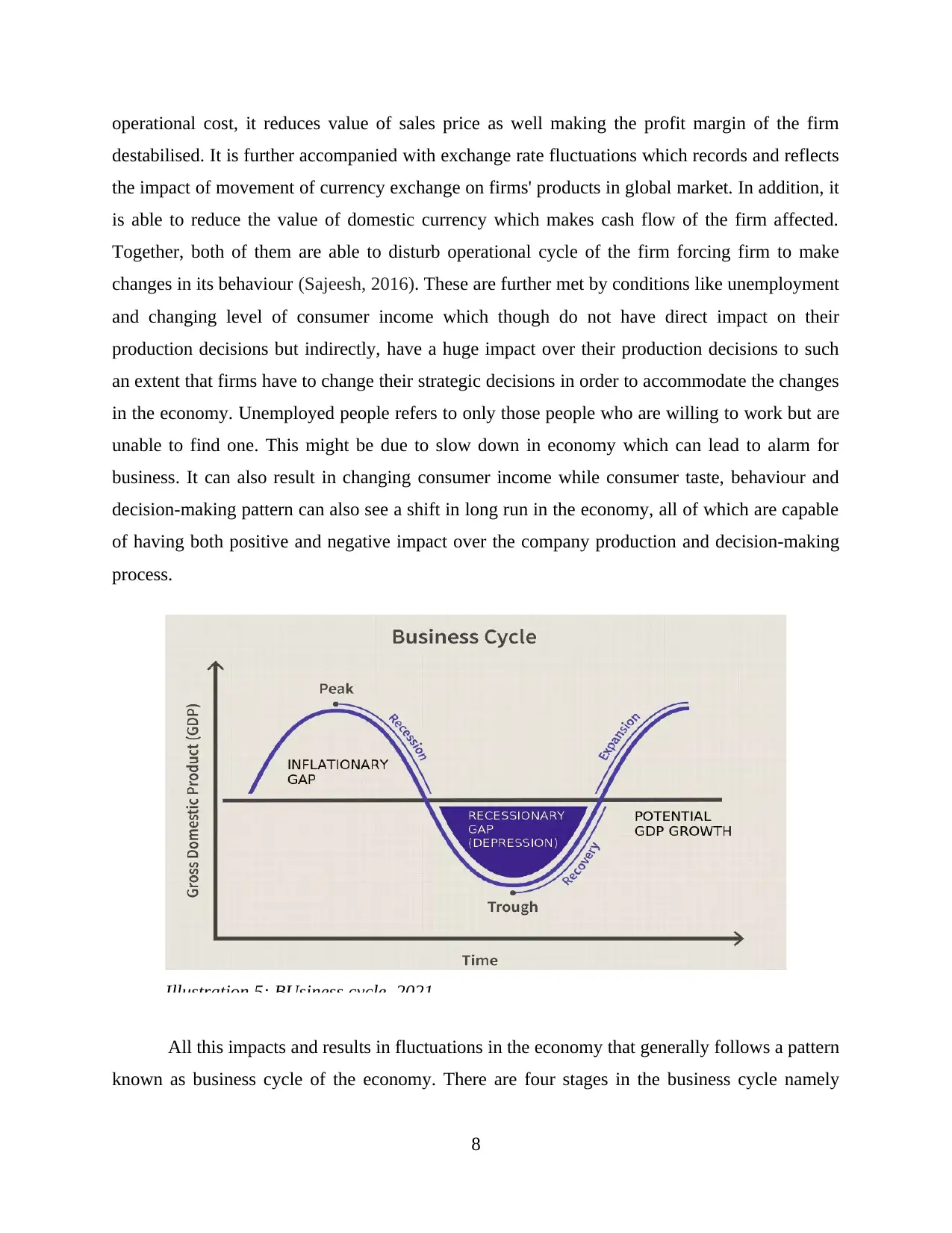
operational cost, it reduces value of sales price as well making the profit margin of the firm
destabilised. It is further accompanied with exchange rate fluctuations which records and reflects
the impact of movement of currency exchange on firms' products in global market. In addition, it
is able to reduce the value of domestic currency which makes cash flow of the firm affected.
Together, both of them are able to disturb operational cycle of the firm forcing firm to make
changes in its behaviour (Sajeesh, 2016). These are further met by conditions like unemployment
and changing level of consumer income which though do not have direct impact on their
production decisions but indirectly, have a huge impact over their production decisions to such
an extent that firms have to change their strategic decisions in order to accommodate the changes
in the economy. Unemployed people refers to only those people who are willing to work but are
unable to find one. This might be due to slow down in economy which can lead to alarm for
business. It can also result in changing consumer income while consumer taste, behaviour and
decision-making pattern can also see a shift in long run in the economy, all of which are capable
of having both positive and negative impact over the company production and decision-making
process.
All this impacts and results in fluctuations in the economy that generally follows a pattern
known as business cycle of the economy. There are four stages in the business cycle namely
8
Illustration 5: BUsiness cycle, 2021
destabilised. It is further accompanied with exchange rate fluctuations which records and reflects
the impact of movement of currency exchange on firms' products in global market. In addition, it
is able to reduce the value of domestic currency which makes cash flow of the firm affected.
Together, both of them are able to disturb operational cycle of the firm forcing firm to make
changes in its behaviour (Sajeesh, 2016). These are further met by conditions like unemployment
and changing level of consumer income which though do not have direct impact on their
production decisions but indirectly, have a huge impact over their production decisions to such
an extent that firms have to change their strategic decisions in order to accommodate the changes
in the economy. Unemployed people refers to only those people who are willing to work but are
unable to find one. This might be due to slow down in economy which can lead to alarm for
business. It can also result in changing consumer income while consumer taste, behaviour and
decision-making pattern can also see a shift in long run in the economy, all of which are capable
of having both positive and negative impact over the company production and decision-making
process.
All this impacts and results in fluctuations in the economy that generally follows a pattern
known as business cycle of the economy. There are four stages in the business cycle namely
8
Illustration 5: BUsiness cycle, 2021
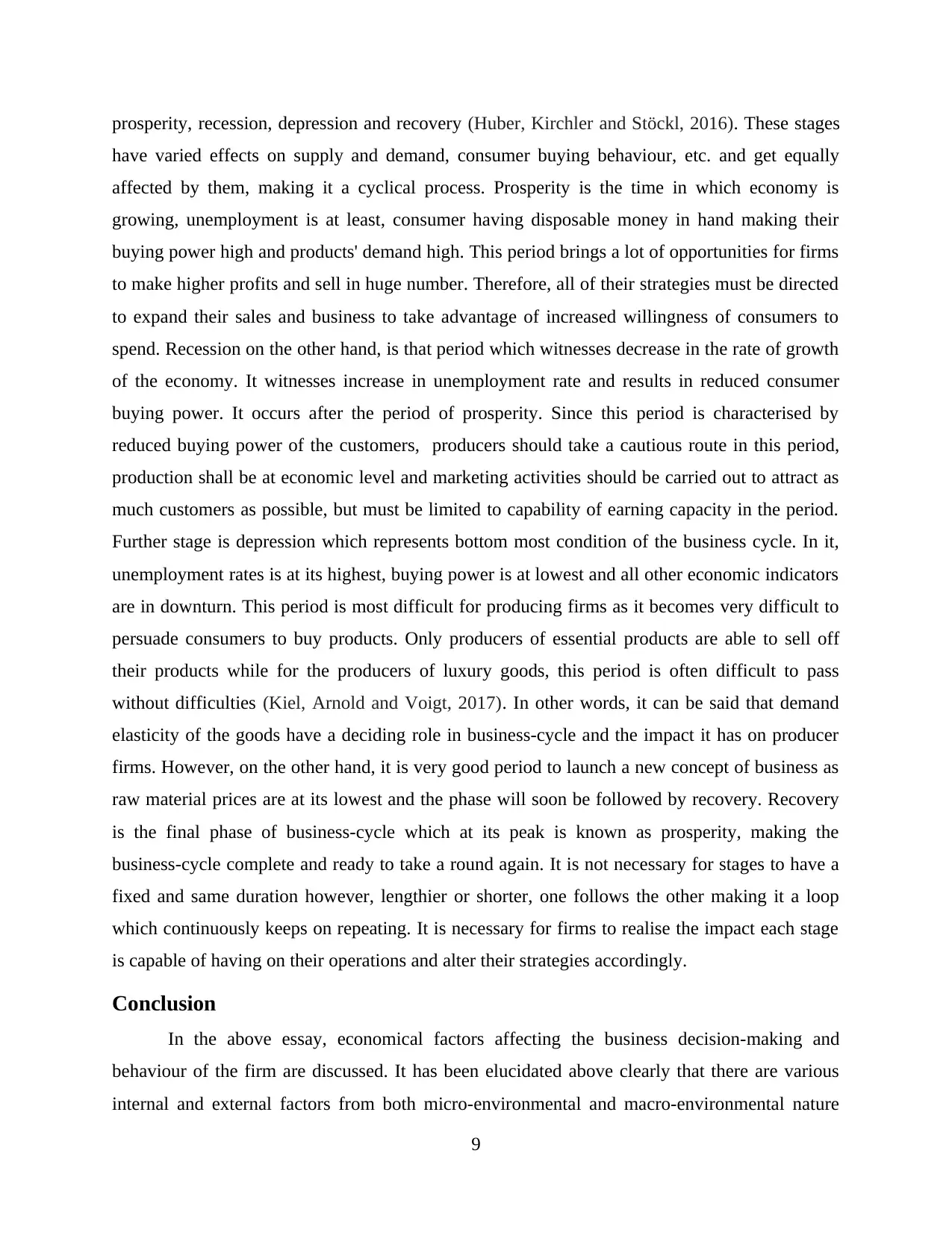
prosperity, recession, depression and recovery (Huber, Kirchler and Stöckl, 2016). These stages
have varied effects on supply and demand, consumer buying behaviour, etc. and get equally
affected by them, making it a cyclical process. Prosperity is the time in which economy is
growing, unemployment is at least, consumer having disposable money in hand making their
buying power high and products' demand high. This period brings a lot of opportunities for firms
to make higher profits and sell in huge number. Therefore, all of their strategies must be directed
to expand their sales and business to take advantage of increased willingness of consumers to
spend. Recession on the other hand, is that period which witnesses decrease in the rate of growth
of the economy. It witnesses increase in unemployment rate and results in reduced consumer
buying power. It occurs after the period of prosperity. Since this period is characterised by
reduced buying power of the customers, producers should take a cautious route in this period,
production shall be at economic level and marketing activities should be carried out to attract as
much customers as possible, but must be limited to capability of earning capacity in the period.
Further stage is depression which represents bottom most condition of the business cycle. In it,
unemployment rates is at its highest, buying power is at lowest and all other economic indicators
are in downturn. This period is most difficult for producing firms as it becomes very difficult to
persuade consumers to buy products. Only producers of essential products are able to sell off
their products while for the producers of luxury goods, this period is often difficult to pass
without difficulties (Kiel, Arnold and Voigt, 2017). In other words, it can be said that demand
elasticity of the goods have a deciding role in business-cycle and the impact it has on producer
firms. However, on the other hand, it is very good period to launch a new concept of business as
raw material prices are at its lowest and the phase will soon be followed by recovery. Recovery
is the final phase of business-cycle which at its peak is known as prosperity, making the
business-cycle complete and ready to take a round again. It is not necessary for stages to have a
fixed and same duration however, lengthier or shorter, one follows the other making it a loop
which continuously keeps on repeating. It is necessary for firms to realise the impact each stage
is capable of having on their operations and alter their strategies accordingly.
Conclusion
In the above essay, economical factors affecting the business decision-making and
behaviour of the firm are discussed. It has been elucidated above clearly that there are various
internal and external factors from both micro-environmental and macro-environmental nature
9
have varied effects on supply and demand, consumer buying behaviour, etc. and get equally
affected by them, making it a cyclical process. Prosperity is the time in which economy is
growing, unemployment is at least, consumer having disposable money in hand making their
buying power high and products' demand high. This period brings a lot of opportunities for firms
to make higher profits and sell in huge number. Therefore, all of their strategies must be directed
to expand their sales and business to take advantage of increased willingness of consumers to
spend. Recession on the other hand, is that period which witnesses decrease in the rate of growth
of the economy. It witnesses increase in unemployment rate and results in reduced consumer
buying power. It occurs after the period of prosperity. Since this period is characterised by
reduced buying power of the customers, producers should take a cautious route in this period,
production shall be at economic level and marketing activities should be carried out to attract as
much customers as possible, but must be limited to capability of earning capacity in the period.
Further stage is depression which represents bottom most condition of the business cycle. In it,
unemployment rates is at its highest, buying power is at lowest and all other economic indicators
are in downturn. This period is most difficult for producing firms as it becomes very difficult to
persuade consumers to buy products. Only producers of essential products are able to sell off
their products while for the producers of luxury goods, this period is often difficult to pass
without difficulties (Kiel, Arnold and Voigt, 2017). In other words, it can be said that demand
elasticity of the goods have a deciding role in business-cycle and the impact it has on producer
firms. However, on the other hand, it is very good period to launch a new concept of business as
raw material prices are at its lowest and the phase will soon be followed by recovery. Recovery
is the final phase of business-cycle which at its peak is known as prosperity, making the
business-cycle complete and ready to take a round again. It is not necessary for stages to have a
fixed and same duration however, lengthier or shorter, one follows the other making it a loop
which continuously keeps on repeating. It is necessary for firms to realise the impact each stage
is capable of having on their operations and alter their strategies accordingly.
Conclusion
In the above essay, economical factors affecting the business decision-making and
behaviour of the firm are discussed. It has been elucidated above clearly that there are various
internal and external factors from both micro-environmental and macro-environmental nature
9
⊘ This is a preview!⊘
Do you want full access?
Subscribe today to unlock all pages.

Trusted by 1+ million students worldwide
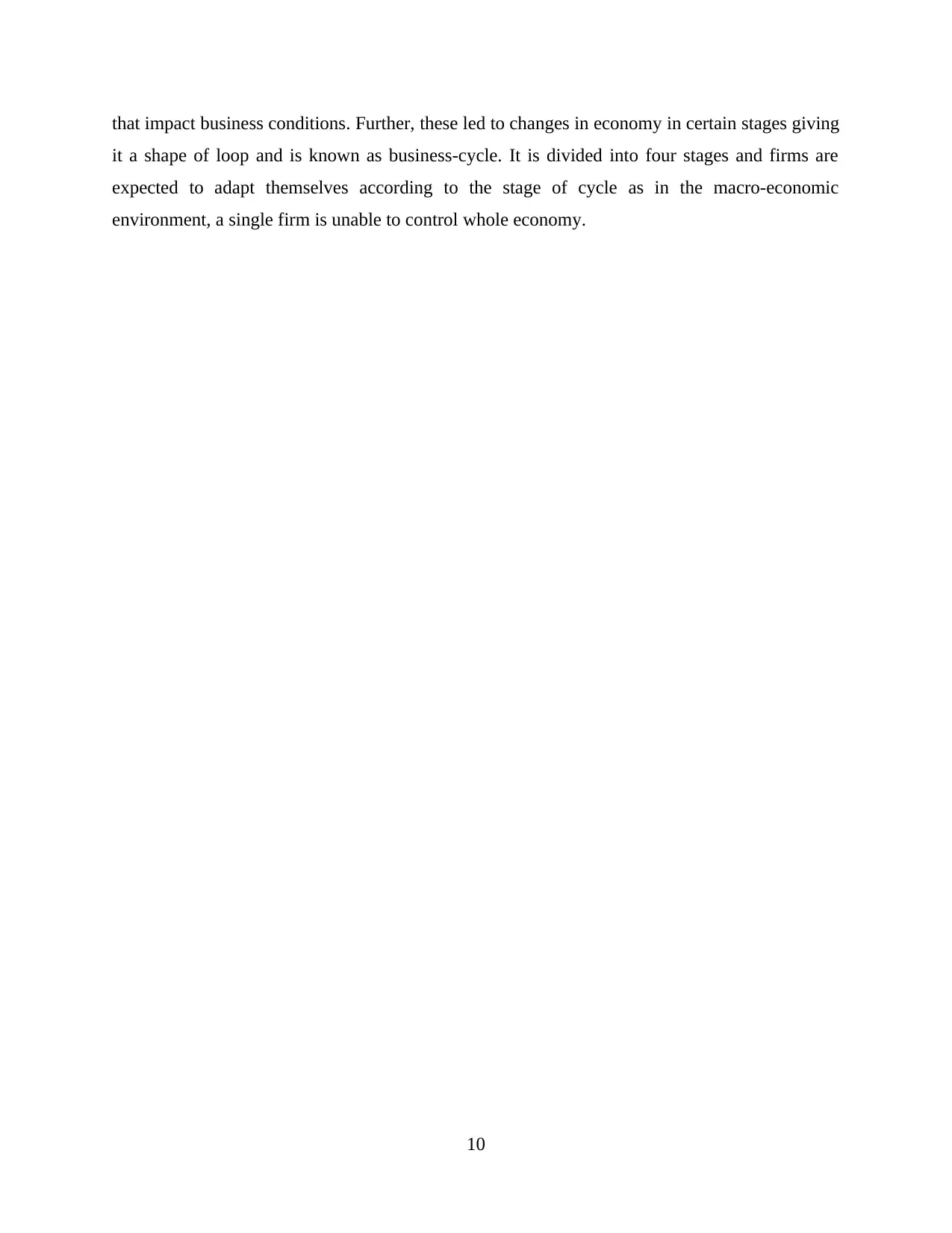
that impact business conditions. Further, these led to changes in economy in certain stages giving
it a shape of loop and is known as business-cycle. It is divided into four stages and firms are
expected to adapt themselves according to the stage of cycle as in the macro-economic
environment, a single firm is unable to control whole economy.
10
it a shape of loop and is known as business-cycle. It is divided into four stages and firms are
expected to adapt themselves according to the stage of cycle as in the macro-economic
environment, a single firm is unable to control whole economy.
10
Paraphrase This Document
Need a fresh take? Get an instant paraphrase of this document with our AI Paraphraser
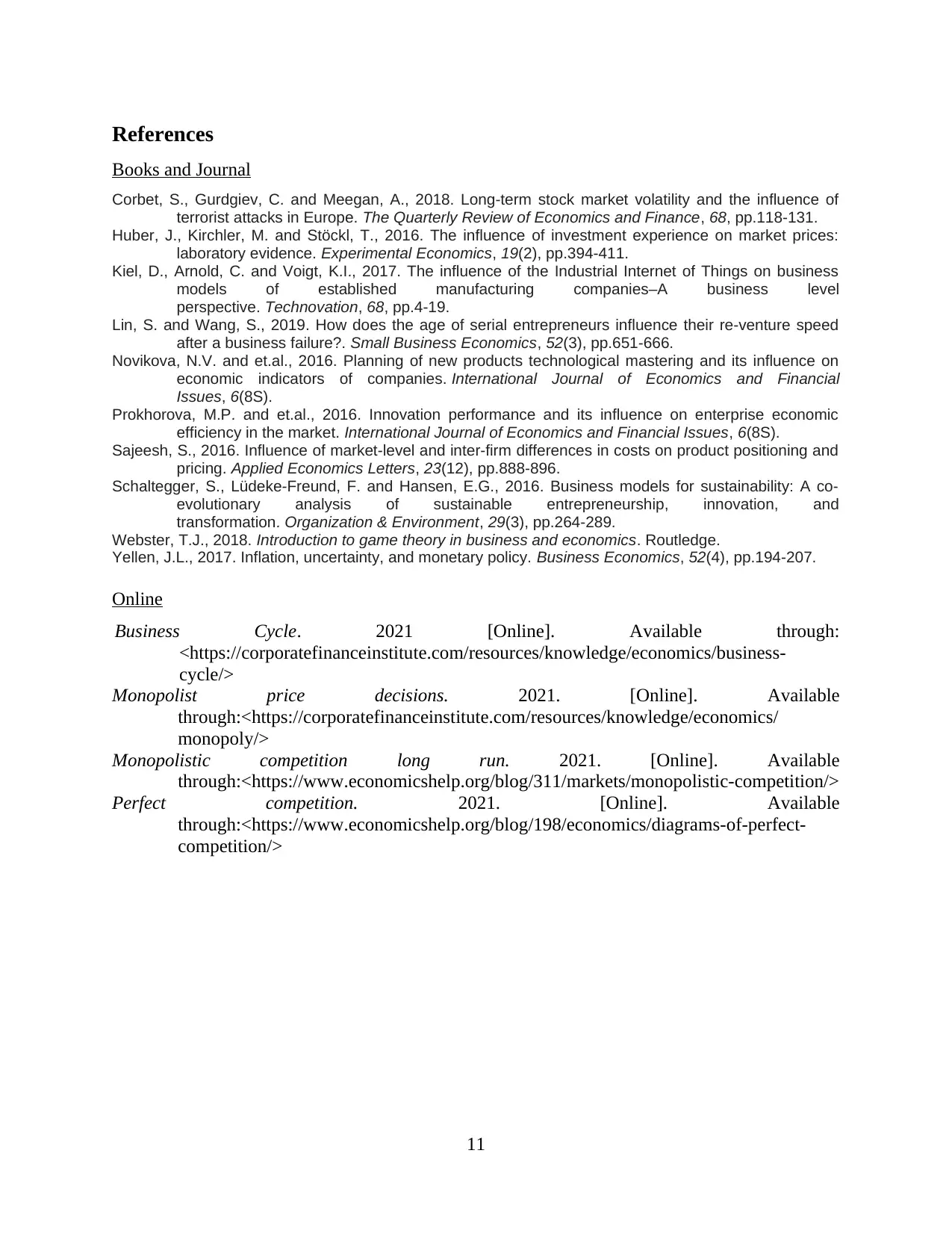
References
Books and Journal
Corbet, S., Gurdgiev, C. and Meegan, A., 2018. Long-term stock market volatility and the influence of
terrorist attacks in Europe. The Quarterly Review of Economics and Finance, 68, pp.118-131.
Huber, J., Kirchler, M. and Stöckl, T., 2016. The influence of investment experience on market prices:
laboratory evidence. Experimental Economics, 19(2), pp.394-411.
Kiel, D., Arnold, C. and Voigt, K.I., 2017. The influence of the Industrial Internet of Things on business
models of established manufacturing companies–A business level
perspective. Technovation, 68, pp.4-19.
Lin, S. and Wang, S., 2019. How does the age of serial entrepreneurs influence their re-venture speed
after a business failure?. Small Business Economics, 52(3), pp.651-666.
Novikova, N.V. and et.al., 2016. Planning of new products technological mastering and its influence on
economic indicators of companies. International Journal of Economics and Financial
Issues, 6(8S).
Prokhorova, M.P. and et.al., 2016. Innovation performance and its influence on enterprise economic
efficiency in the market. International Journal of Economics and Financial Issues, 6(8S).
Sajeesh, S., 2016. Influence of market-level and inter-firm differences in costs on product positioning and
pricing. Applied Economics Letters, 23(12), pp.888-896.
Schaltegger, S., Lüdeke-Freund, F. and Hansen, E.G., 2016. Business models for sustainability: A co-
evolutionary analysis of sustainable entrepreneurship, innovation, and
transformation. Organization & Environment, 29(3), pp.264-289.
Webster, T.J., 2018. Introduction to game theory in business and economics. Routledge.
Yellen, J.L., 2017. Inflation, uncertainty, and monetary policy. Business Economics, 52(4), pp.194-207.
Online
Business Cycle. 2021 [Online]. Available through:
<https://corporatefinanceinstitute.com/resources/knowledge/economics/business-
cycle/>
Monopolist price decisions. 2021. [Online]. Available
through:<https://corporatefinanceinstitute.com/resources/knowledge/economics/
monopoly/>
Monopolistic competition long run. 2021. [Online]. Available
through:<https://www.economicshelp.org/blog/311/markets/monopolistic-competition/>
Perfect competition. 2021. [Online]. Available
through:<https://www.economicshelp.org/blog/198/economics/diagrams-of-perfect-
competition/>
11
Books and Journal
Corbet, S., Gurdgiev, C. and Meegan, A., 2018. Long-term stock market volatility and the influence of
terrorist attacks in Europe. The Quarterly Review of Economics and Finance, 68, pp.118-131.
Huber, J., Kirchler, M. and Stöckl, T., 2016. The influence of investment experience on market prices:
laboratory evidence. Experimental Economics, 19(2), pp.394-411.
Kiel, D., Arnold, C. and Voigt, K.I., 2017. The influence of the Industrial Internet of Things on business
models of established manufacturing companies–A business level
perspective. Technovation, 68, pp.4-19.
Lin, S. and Wang, S., 2019. How does the age of serial entrepreneurs influence their re-venture speed
after a business failure?. Small Business Economics, 52(3), pp.651-666.
Novikova, N.V. and et.al., 2016. Planning of new products technological mastering and its influence on
economic indicators of companies. International Journal of Economics and Financial
Issues, 6(8S).
Prokhorova, M.P. and et.al., 2016. Innovation performance and its influence on enterprise economic
efficiency in the market. International Journal of Economics and Financial Issues, 6(8S).
Sajeesh, S., 2016. Influence of market-level and inter-firm differences in costs on product positioning and
pricing. Applied Economics Letters, 23(12), pp.888-896.
Schaltegger, S., Lüdeke-Freund, F. and Hansen, E.G., 2016. Business models for sustainability: A co-
evolutionary analysis of sustainable entrepreneurship, innovation, and
transformation. Organization & Environment, 29(3), pp.264-289.
Webster, T.J., 2018. Introduction to game theory in business and economics. Routledge.
Yellen, J.L., 2017. Inflation, uncertainty, and monetary policy. Business Economics, 52(4), pp.194-207.
Online
Business Cycle. 2021 [Online]. Available through:
<https://corporatefinanceinstitute.com/resources/knowledge/economics/business-
cycle/>
Monopolist price decisions. 2021. [Online]. Available
through:<https://corporatefinanceinstitute.com/resources/knowledge/economics/
monopoly/>
Monopolistic competition long run. 2021. [Online]. Available
through:<https://www.economicshelp.org/blog/311/markets/monopolistic-competition/>
Perfect competition. 2021. [Online]. Available
through:<https://www.economicshelp.org/blog/198/economics/diagrams-of-perfect-
competition/>
11
1 out of 11
Related Documents
Your All-in-One AI-Powered Toolkit for Academic Success.
+13062052269
info@desklib.com
Available 24*7 on WhatsApp / Email
![[object Object]](/_next/static/media/star-bottom.7253800d.svg)
Unlock your academic potential
Copyright © 2020–2025 A2Z Services. All Rights Reserved. Developed and managed by ZUCOL.




